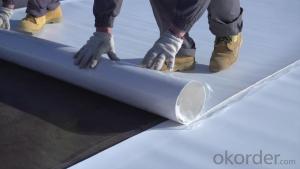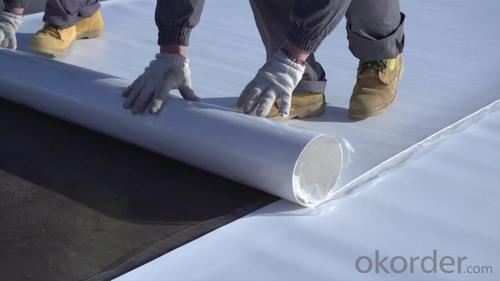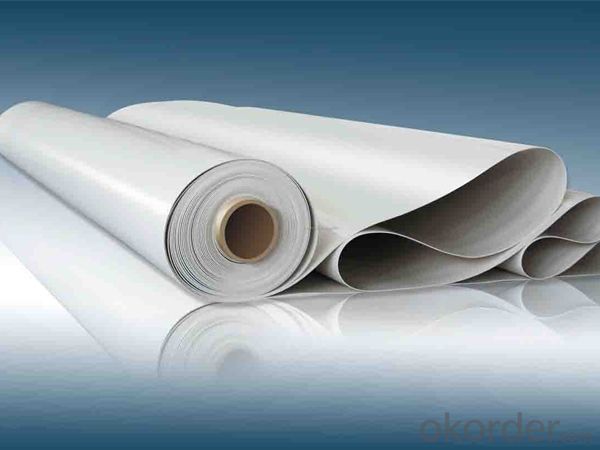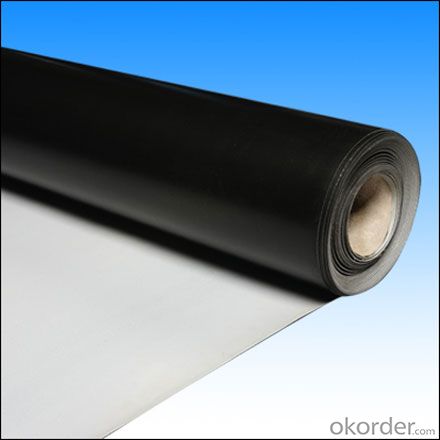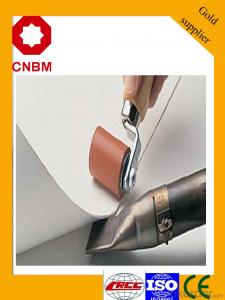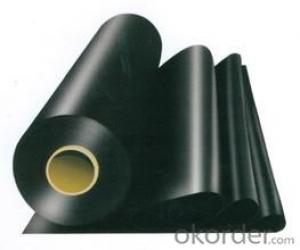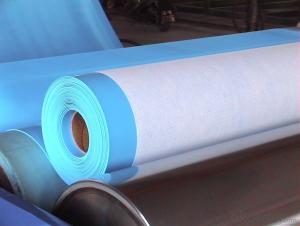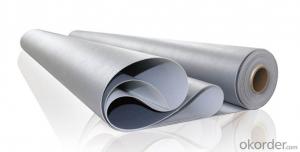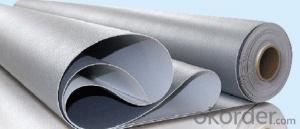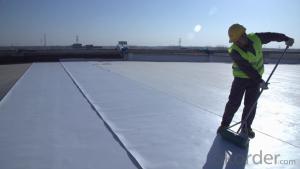TPO Waterproof Membrane for Roofing Market
- Loading Port:
- Qingdao
- Payment Terms:
- TT or LC
- Min Order Qty:
- 20000 m²
- Supply Capability:
- 600000 m²/month
OKorder Service Pledge
OKorder Financial Service
You Might Also Like
Product Description of TPO Waterproof Membrane for Roofing Market:
TPO Waterproof Membrane for Roofing Market is based on polypropylene and EP (ethylene-propylene) rubber polymerized together by using state-of-the-art polymer manufacturing technology. This technology enables BAIRUI TPO membranes flexible at low temperatures without the use of polymeric or liquid plasticizers. BAIRUI TPO membranes fall into two main types: Homogeneous TPO & Reinforced TPO. Reinforced TPO has a polyester mesh layer in the middle, which provides reinforced membranes with high breaking and tearing strength and puncture resistance."
Product features of TPO Waterproof Membrane for Roofing Market:
1.high reflectivity,anti-ultraviolet radiation,do not need to be protection,energy saving and environmental protection.
2.long-term weathering resistance,resistance to ultravoilet radiation and heat aging,density is small.
3..high elasticity,high strength,high elongation,good suppleness.
4.effectively resist harmful chemicals,industrial pollutants erosion,wear resistance,resistance to puncture.
5.with automatic quench.
Technical Parameters of TPO Waterproof Membrane for Roofing Market:
No. | Item | Index | |||
1 | mm≥ thickness of resin layer above inermediate tire mm ≥ | - | - | 0.4 | |
2 | tensile property | N/cm ≥ maximum tensile force N/cm ≥ | - | 200 | 250 |
MPa ≥ tensile Strength MPa ≥ | 12.0 | - | - | ||
≥ elongation at maximun tensile force% ≥ | - | - | 15 | ||
% ≥ elongation at fracture % ≥ | 500 | 250 | - | ||
3 | size change rate under heat treatment %≤ | 2.0 | 1.0 | 0.5 | |
4 | flexibility at low temperature | no crack at -40°c | |||
5 | unpermeability | 0.3Mpa,2h waterproof | |||
FRQ:
What is your main market?
Our Tpo Roofing Membrane with Superior Raw Material for Roofing Market sells very well in USA, United Kingdom, Austrilia, Canada, Japan, Pakistan, etc.
What is your advantage for Tpo Roofing Membrane?
With the most advanced production line, our good quality is based on superior material imported from America. We have different color available and could produce any color you want.
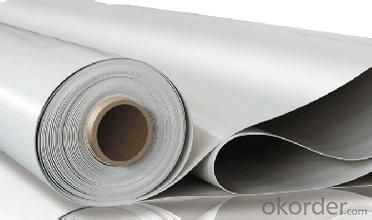
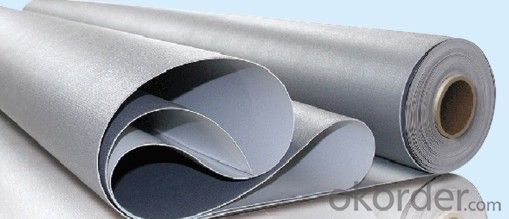
- Q: Does a waterproofing membrane provide any insulation against temperature fluctuations?
- A waterproofing membrane does not provide insulation against temperature fluctuations. The primary function of a waterproofing membrane is to prevent the penetration of water or moisture into the protected area. It acts as a barrier to keep the structure dry and protect it from potential water damage. While it may offer some degree of thermal resistance due to its thickness and material properties, it is not designed or intended to provide insulation against temperature fluctuations. To provide insulation, other materials like insulation foam or insulation boards are typically used in construction.
- Q: Can waterproofing membranes be used on mechanical equipment rooms?
- Yes, waterproofing membranes can be used on mechanical equipment rooms. These membranes are designed to provide a protective barrier against water intrusion and prevent moisture damage to the underlying structures. Mechanical equipment rooms, which often house sensitive and expensive equipment, can benefit from the installation of waterproofing membranes to ensure the longevity and functionality of the machinery. By applying waterproofing membranes to the walls, floors, and ceilings of these rooms, it helps prevent water leaks, moisture buildup, and potential damage caused by water infiltration. This can be particularly important in areas prone to heavy rainfall, high humidity, or where the water table is high. Waterproofing membranes can also help in controlling condensation and preventing mold growth, which can be detrimental to the performance of mechanical equipment. Overall, the use of waterproofing membranes in mechanical equipment rooms is a practical and effective solution to protect the equipment and maintain their optimal performance.
- Q: Can a waterproofing membrane be used in boat decks or marinas?
- Yes, a waterproofing membrane can be used in boat decks or marinas. Boat decks and marinas are constantly exposed to water, making them prone to damage and deterioration over time. A waterproofing membrane can provide an effective solution to protect these surfaces from water intrusion, preventing issues such as rotting, warping, and mold growth. The membrane acts as a barrier, preventing water from seeping into the underlying structure and causing damage. It also helps to maintain the structural integrity of the boat deck or marina, prolonging its lifespan. Additionally, a waterproofing membrane can enhance the safety of these surfaces by reducing the risk of slip and fall accidents, as it can provide a slip-resistant surface. Overall, using a waterproofing membrane in boat decks or marinas is a wise choice to ensure their durability, longevity, and safety.
- Q: Does a waterproofing membrane require any maintenance or regular inspections?
- Indeed, the maintenance and regular inspection of a waterproofing membrane are necessary. Although these membranes are built to be robust and have a prolonged lifespan, they are still susceptible to the effects of wear and tear and potential harm. Consistent inspections are crucial in order to detect any indications of damage or deterioration promptly, allowing for swift action to prevent further complications. Maintenance tasks may comprise the cleaning of the membrane to eliminate dirt or debris, mending any visible cracks or tears, and guaranteeing appropriate drainage and water flow. Furthermore, it is advisable to adhere to the manufacturer's maintenance guidelines and arrange professional inspections periodically to ensure the waterproofing membrane's efficacy and longevity.
- Q: Can a waterproofing membrane be used for underground stormwater detention systems?
- Yes, a waterproofing membrane can be used for underground stormwater detention systems. Waterproofing membranes are commonly used to prevent water penetration and can be effective in containing stormwater within the underground detention system.
- Q: About asphalt waterproofing membrane
- 5, oil asphalt felt is the asphalt membrane, asphalt membrane is not modified by the coil, usually specifically felt. 6, if it is asphalt-based waterproofing membrane, including non-modified asphalt linoleum, polymer modified SBS coil, oxidized asphalt modified membrane.
- Q: Are waterproofing membranes suitable for tunnels?
- Yes, waterproofing membranes are suitable for tunnels. Tunnels are often subjected to high water pressure from the surrounding soil and groundwater, making them vulnerable to water ingress. Waterproofing membranes are designed to provide a protective barrier against water infiltration and can effectively prevent water from entering the tunnel structure. These membranes are typically made of durable materials such as bitumen, PVC, or EPDM rubber, which are resistant to water penetration. They are applied to the tunnel walls and ceiling to create a continuous, impermeable layer that keeps the tunnel dry. The membranes are also flexible, allowing them to accommodate any movement or settlement of the tunnel without compromising their waterproofing integrity. In addition to preventing water infiltration, waterproofing membranes also offer other benefits for tunnels. They can protect the tunnel structure from corrosion caused by water and chemicals, prolonging its lifespan. They can also help to improve the indoor air quality within the tunnel by preventing the growth of mold and mildew, which thrive in damp environments. Furthermore, waterproofing membranes can be customized to suit different tunnel conditions. For example, in tunnels that are exposed to high levels of hydrostatic pressure, reinforced membranes with higher tensile strength can be used to withstand the added stress. Additionally, membranes with enhanced fire resistance properties can be utilized in tunnels where fire safety is a concern. Overall, waterproofing membranes are a reliable and effective solution for ensuring the durability, safety, and longevity of tunnels by providing a robust barrier against water ingress.
- Q: What is waterproofing membrane?
- Waterproof membrane is mainly used for building walls, roofs, as well as tunnels, highways, landfills, etc., to resist the external rain, groundwater leakage can be curled into a roll of flexible building materials, as the basis for engineering And no leakage between the building connection, the entire project is the first waterproof barrier, the entire project plays a vital role. The main products are asphalt waterproofing membrane and polymer waterproofing membrane.
- Q: Can a waterproofing membrane be used for planter boxes and green roofs?
- Yes, a waterproofing membrane can be used for planter boxes and green roofs. In fact, it is highly recommended to use a waterproofing membrane in these applications to prevent water leakage and damage to the underlying structures. Planter boxes and green roofs often require a reliable waterproofing system to ensure the longevity and functionality of the design. A waterproofing membrane acts as a barrier, preventing water from seeping into the underlying structures and causing potential damage. For planter boxes, a waterproofing membrane is essential to prevent water from leaking out and damaging the surrounding structures. It also helps to retain the moisture within the planter box, ensuring that plants receive adequate hydration. Similarly, green roofs require a waterproofing membrane to prevent water from infiltrating the roof structure and potentially causing leaks or structural damage. The membrane acts as a protective layer, ensuring that water is properly drained and does not accumulate on the roof surface. When selecting a waterproofing membrane for planter boxes and green roofs, it is important to consider factors such as durability, flexibility, and resistance to root penetration. Some membranes are specifically designed for these applications, providing additional features like root barriers to prevent plant roots from penetrating and damaging the membrane. In conclusion, a waterproofing membrane is an essential component for planter boxes and green roofs. It helps to prevent water leakage, retain moisture, and protect the underlying structures from potential damage caused by water infiltration.
- Q: Does a waterproofing membrane provide any soundproofing benefits?
- A waterproofing membrane, unfortunately, does not offer any advantages in terms of soundproofing. Its sole purpose is to safeguard surfaces against water infiltration, such as roofs, walls, or foundations. It is typically composed of materials like asphalt, rubber, or polyethylene, which are not effective in obstructing or absorbing sound waves. On the other hand, soundproofing entails the utilization of distinctive materials and techniques that can diminish or eradicate the transmission of sound from one area to another. This may involve insulation, acoustic panels, or soundproof barriers. Consequently, if soundproofing is a concern, it is essential to contemplate separate soundproofing measures in conjunction with a waterproofing membrane.
Send your message to us
TPO Waterproof Membrane for Roofing Market
- Loading Port:
- Qingdao
- Payment Terms:
- TT or LC
- Min Order Qty:
- 20000 m²
- Supply Capability:
- 600000 m²/month
OKorder Service Pledge
OKorder Financial Service
Similar products
Hot products
Hot Searches
Related keywords
